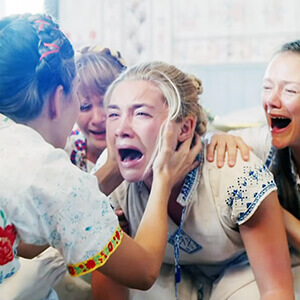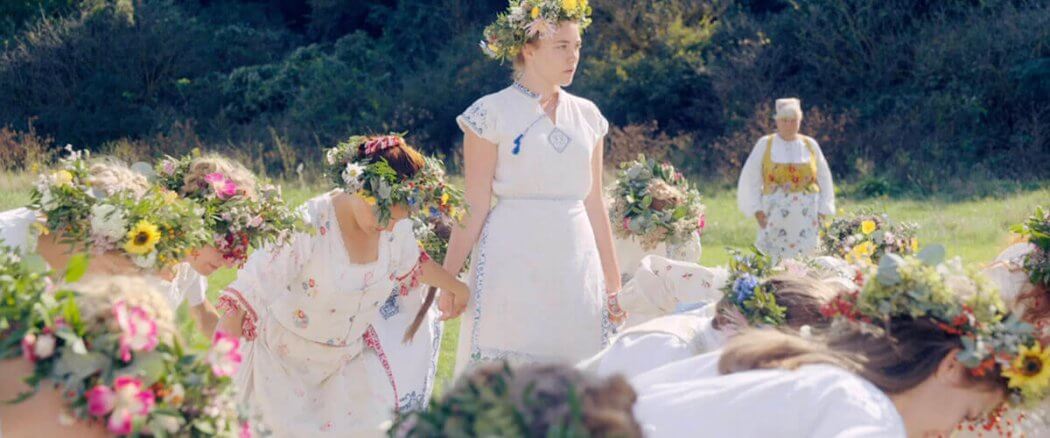Think back to a time in your life when you were going through a breakup — or, if not a breakup, then the unpleasant end of some meaningful relationship.
Maybe you parted ways with a friend over some irreconcilable difference. Perhaps you and a loved one have not spoken due to some deep wounds in your shared past. What feelings do these thoughts dredge up in you? Grief certainly has to be present, as the loss of anything meaningful often leaves a hole that can never be satisfactorily filled. Maybe there is unresolved anger? Guilt could also play a major factor depending on the circumstances.
Loss, especially loss of love (or perceived love), is a minefield of complex emotional trauma — a tapestry woven stronger by a lack of resolution. Clouded memories, misguided judgment, a lack of foundational awareness; do these all feel familiar in the wake of relationships past?
In his sophomore feature film, Midsommar, Ari Aster — the man behind last year’s equally disturbed and inspired Hereditary — seeks to bottle these experiences in the sunwashed fields of Sweden. What results is not only a twisted fable on the consequences of gaslighting, but also a barbaric thesis on the depravity of the human condition and how it perverts even the most beautiful connections between us.
Hälsingland
Part of the success of both Hereditary and Midsommar comes from Aster’s mastery of tone. While both could very comfortably fit within the horror genre, it’s how different they feel that sets Midsommar apart.

Unlike its predecessor, Midsommar is bathed in light. Due to the Nordic setting, the young band of “protagonists” is rarely forced to face the dark of night, and even then it’s more of a dusk. We are fully aware of their surroundings at all times, lending Aster and his team full control of our faculties. From there, the on-screen manipulation — from warped backdrops to hyperactive camera movement — can have a greater effect on us as viewers, unsettling the ground under our feet as it does the characters in the frame.
It doesn’t help that Henrik Svensson’s mise en scène is so rapturous. Pastel colors and lily white gowns dot the picturesque blue skies and green fields of the Hälsingland, allowing us to lower our defenses so that Aster’s way with unnerving imagery can have its full effect.
Even then, it’s hard to categorize Aster’s choices as sadistic. Much of the film’s most disturbing imagery comes within the context of carefully executed rituals, giving the whole of the movie a tightly constructed frame. What are we to do with a film so intentionally beautiful, yet so morally reprehensible? If traditional horror fare is designed to steep viewers in the darkness, thereby putting them in the right mental frame for the darkness to follow, how can they reconcile that same darkness under the gaze of the noon sun? It would seem that Aster’s goal is for that reconciliation to be difficult, if not impossible.
Personer
Aster’s intentionally unsettled tone is accentuated by a group of performances that allow the audience an avatar with which to identify. From bewilderment (Florence Pugh’s Dani) to fascination (William Jackson Harper’s Josh) to indifference (Jack Reynor’s Christian), there seems to be someone to hold onto for every possible reaction.
For all the natural beauty in Midsommar, it’s the people that garner the most attention. Clad in flowing white smocks and dresses, the residents of the Hälsingland create a sort of blank, amoral canvas on which to project thoughts and feelings. There’s a sort of fluid rigidity to the actors’ performances that suggest normalcy, while our brains tell us that the images we’re seeing are anything but.
Of course, this could just be Aster making a statement on American cultural tourism. More likely though, it’s a reflection of our natural tendency toward ritual. In every culture and religion throughout time, ritual makes up the fabric of community life, the recognition that life is not just personal, but shared.

In fact, it’s this rejection of intense individualism that defines Dani’s arc. From the moment we meet her and Christian, we’re given the impression that Dani is emotionally isolated. We see it in the way she is constantly pining to be with Christian, despite his lack of physical and emotional intimacy. It defines her inability (or perhaps indifference?) to read social cues when she accepts the invite to Sweden. Dani, defined in this stage of her life by unspeakable tragedy, is alone and desperately seeking a family to love her and grieve with her. It’s a wholesome desire — “mourn with those who mourn,” Paul commands in Romans 12 — that is corrupted by a lack of stable care in the wake of her trauma. It’s an opportunity that is seized by Pelle and his community, who fill an important role for Dani as she processes the horrors of her past and present.
This same individualism is rejected in other ways, specifically through the methodical dispatching of Dani’s companions. A literal reading of her friends’ fates could be found in James where each one is, “dragged away by their own evil desire.” It’s not inherently evil to be transfixed by a foreign culture, like Josh, or to seek pleasure in new experiences (as Will Poulter’s Mark is intent on doing). But when fascination and pleasure-seeking lead to intrusion and willful disregard for others, judgement is cast.
In an even more damning manner, none of the offending parties are actually seen meeting their demise. Aster seems to be more concerned with cosmic judgement than the details of their grisly ends, each being preceded by an offense that either the villagers or the audience cannot stand to go unpunished. In keeping with the moral projection, none of these ends are seen (in the context of the story) as anything other than the natural progression of life; it’s an inevitability rather than a punishment. But the use of the Hälsingland as a sort of proving ground for its visitors inevitably leads us back to the one person amongst the visitors who seeks out, and thrives in the presence of, supportive companionship.
Hårga
If, at it’s best, Midsommar is a fable on the importance of supportive community, it’s also a reminder of the corrupting ability of the human heart.
By the time you walk away from Midsommar, it’s undoubtedly hard to process everything. For the length of 140 minutes, Aster takes you out of your reality and into his, a purposeful (and masterful) decision that emphasizes the engagement of the film without a firm foundation on which to stand. When physical space feels impermanent, you necessarily abandon control and go along for the ride.

It feels fitting, then, that the finale of this engrossing, grossed out fairy tale takes place on flat ground. As Dani observes her world going up in flames (not to put too fine a point on it), her new family embraces the fullness of life around them, both the ground on which they lie and the emotions coursing through their newest member. It would be a beautiful scene — one of pure empathy — if it weren’t also so hideous. And as Dani’s visage turns from horror to relief, we cut to black, left with the impression that she has found her new family, one who will see her through these complex traumas in a way her old family could not.
Midsommar is not shy about its grotesqueries. Much like his preceding work, Aster is content to bathe in horrors of trauma. He gives them external life on the screen, a visceral representation of the internal horrors we all encounter at some point in our lives.
However, Midsommar — unlike Hereditary — is also concerned with the beauty of life — especially communal life — and how it is not wholly separate from the depravity of the human condition. As much as we like to believe that there is good and there is bad and the two shall nary meet, Midsommar wisely posits that the soil is poisoned. Even the most beautiful things contain rot, and there is nothing that won’t be brought to light, especially in the midsummer sun.





